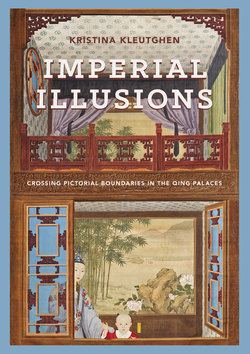Читать книгу Imperial Illusions - Kristina Kleutghen - Страница 80
На сайте Литреса книга снята с продажи.
Оглавлениеotherwise unacknowledged in China at the time. Two copies of the Perspectiva were held in the Jesuits’ Beijing library at the North Church (Beitang), one published in Rome 1702–23 and one in Augsburg in 1706–19,47 but these were not the only European perspective treatises held there. While The Study of Vision certainly borrowed some illustrations from the Perspectiva, it also borrowed from other treatises, and never acknowledges either its textual or pictorial sources. The European treatises that can be visually linked to The Study of Vision were merely frameworks to be built upon in the service of a new style of painting.
The “image-led graphic instruction and design ideas” of the Perspectiva have been credited as the reasons for its international spread with the global Jesuit missions throughout Europe, to the Americas, and to Goa and China.48 The extremely low text-to-image ratio in The Study of Vision has even led to suggestions that the Perspectiva illustrations were self-explanatory to non-European viewers; such suggestions presume dangerously that both the style and the content were legible. The Study of Vision has therefore been promoted as syncretic evidence that Pozzo’s illustrations broke through language barriers to function as legible didactic images that signified clearly regardless of the texts that accompanied them.49 Such an assessment overlooks the fact that promoting this particular treatise, produced by one of their own fully professed members, would naturally have been in the Jesuits’ best interests in China, particularly after proselytization was prohibited. Furthermore, while the subjects, representational styles, and pictorial techniques of the Perspectiva were likely more legible to Nian due to his training in Western mathematics and art, even he was not immune to misinterpreting them, as later illustrations will show.
Many of the illustrations that Nian borrowed from the Perspectiva are in fact quite far from self-explanatory in his presentation, even when accompanied by text. An example comes early in the first section, in the illustration describing the method for projecting a pedestal in perspective (7r, figure 2.3), the eighth figure in the Perspectiva. Again depicted in a simplified outline mirror reversal from Pozzo’s original, Nian’s illustration is divided into four parts. At the top left is the geometrical elevation of the pedestal; below is the geometrical plan of the base. Dotted lines connect the two views, linking the two figures as two views of a single object. In the top half of the larger main part of the illustration, the geometrical elevation is rotated ninety degrees into a foreshortened view of the side of the column, with the orthogonals of the resulting perspective elevation and plan extending sharply up to the vanishing point (zhengtoudian) at the top right corner. The bottom portion of the illustration presents the completed outline projection of the pedestal with a horizon line behind it, situating the pedestal base on a ground plane, as it appears to have two sides that recede horizontally into the distance and extend vertically in space.
In contrast to Pozzo’s lengthy instructions accompanying his version of the image, Nian’s directions simply read, “First draw the base; next draw the main face; then draw the side face. [With] the dimensions of the four surrounding [sides] all prepared, therefore, completing the figure should not be vexing or confusing, but certain. This is the same method as in the previous square figure; similar figures can be inferred. Everything can
